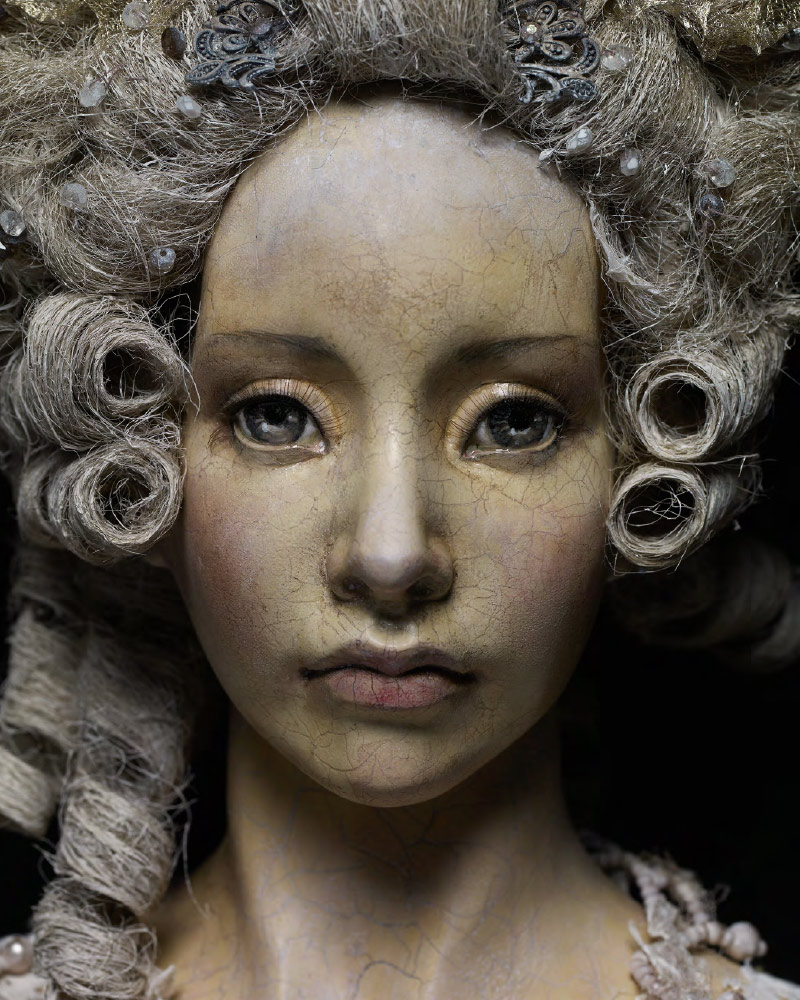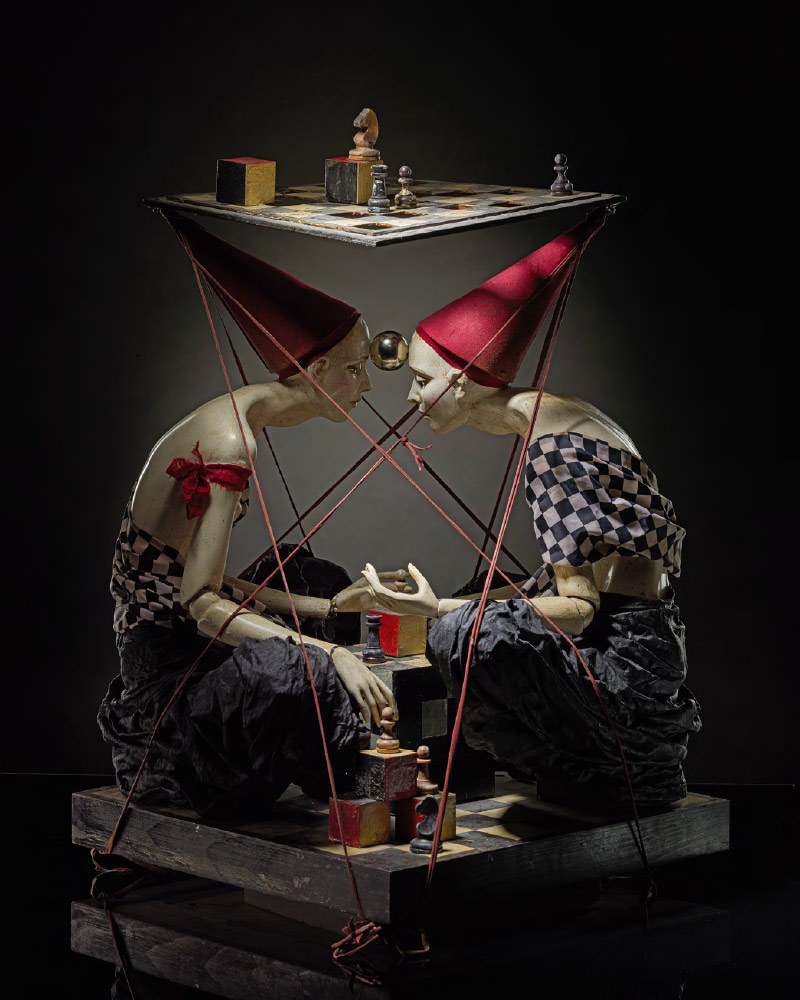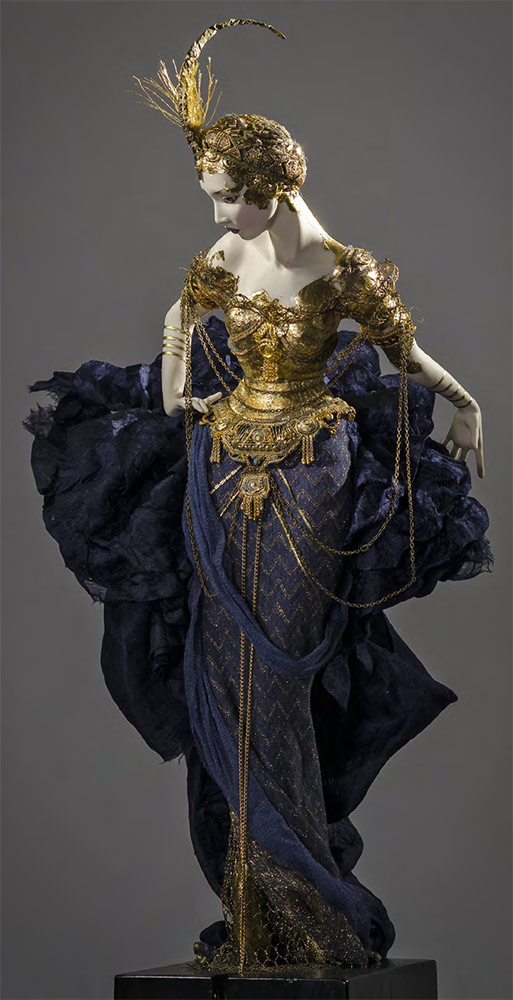Alexandra Khudyakova. "Love dolls like the Queen loved them"
“And who would disagree that of all the mysteries that interest human beings 'the mystery of the doll’ is the most essential, the most captivating?”
Mikhail Saltykov-Shchedrin. ‘The Little People Who Make Toys’. From the “Fairy Tales”
“Dolls are living creatures to the extent that we, people, put life into them.
I see nothing mystical about it.” Alexandra Khudyakova
* Britain’s Queen Victoria, when a child, was fond of making dresses for her dolls, of which she had more than 130.
The relatively new art of doll making has developed in a short space of time into a scintillating new form, combining aesthetic elements adopted from a range of older artistic genres with decorative attributes drawn from a wide perspective of history. This young form has reached a concentration of perfection in the work of Alexandra Khudyakova, an artist who creates a cornucopia of visual riches, one which can be as elaborate in its detail as it remains tantalizing and allusive in meaning.

Doll. 2007
Flumo, textile. Height - 140 cm. Photograph by А. Losev
One of the most serious steps taken by Homo erectus on its path to Homo Ludens and Homo sapiens was the attempt to develop an abstract model of the surrounding world, and one of the fruits of this endeavour was what we might call the “toy". Thousands of years later, such objects have developed into anthropomorphic playthings which somehow imitate the appearance of a human being, from the youngest toddler to the most frail old man or woman. Both the word “doll", and our understanding of a doll, have become attached to this kind of a toy. The doll became a metaphor of age, gender, family, occupation - even of life and death, if you wish. And at some point dolls have changed places with human beings: people who obey the commands of others have come to be known as “marionettes", while beautiful heartless women are called “dolls".
“Designer" dolls emerged towards the end of the 20th century, constituting the expression of a highly artistic aesthetic in a strikingly new vein - but quite what vein exactly? That of the decorative arts, or perhaps of sculpture? In other words, the master doll maker came into his or her own: in Russia this “tribe" has consisted of professional artists creating dolls unlike anything that either children or adults would play with in any accustomed sense. Such dolls are objets d’art in the spirit of fantastical or romantic art, of photo- or hyperrealism, of surrealism. They have the beauty and exquisite prettiness of salon art, often combined with elements of the hi-tech, created from expensive materials and elaborate technical means necessary for the creation of a true treasure: they are objects of art that somehow create around them a space of special emotional impact and attraction and, therefore, of interaction, too. Often those who own such masterpieces become as attached to their dolls as they might be to a favourite pet.
What mysteries have always been associated with dolls! From the “Tales" of E.T.A. Hoffmann like “The Nutcracker and the Mouse King", to Bolesfaw Prus's novel “The Doll", intended for adult readers, of course, but whose name holds such appeal for children; from Dina Rubina's novel “Petrushka's Syndrome", or Yury Olesha's “Three Fat Men" with its doll, Suok, that comes to life, to that so vividly described doll-girl pattern of Adelaida Gertsyk's story about her son, “From the World of Children's Games" or the 2016 horror film “The Boy" by the American director William Brent Bell. It should be noted that finding a Russian equivalent for the title of the film “The Boy" gave birth to the doll-boy pattern: the original title builds associations with a live boy, though in a Russian variant the word “doll" does not leave room for a live object. This juxtaposition explains the fact of horror: the heroine Greta is hired as babysitter to a porcelain doll named Brahms who appears to be a counterpart of the real Brahms. And so many more, that shroud of mystery enveloping the doll makers, too. “Those who make dolls and those who love dolls enjoy reinvigorating their feelings and dreams through games. The doll, whose very nature is connected to play, becomes just such a highly precious object, one through which people can satisfy this need." Alexandra Khudyakova's words surely deserve to preface any essay about the work of this famous Russian doll-maker artist.

The Magic of the Game. 2017
Flumo, textile. Height - 80 cm. Photograph by M. Poluboyarinov
Like every young girl, Alexandra first encountered dolls - a whole variety of them - as a child, the beginning of an experience that would deepen appreciably by 1992, when she completed her graduation diploma on designer dolls at the Department of Design of the Stroganov School, under the tutorship of Xenia Kondratieva. A researcher of material culture and decorative art, Kondratieva passed on to her student the confidence that she had chosen the right occupation for herself, as well as an understanding that designer dolls themselves had a future. Within less than two decades, the art of doll making would leap from its erstwhile niche in subculture to become an independent art form that today exists alongside, and on equal terms with, the classic forms of painting, sculpture, drawing and decorative art. Khudyakova duly became one of the main initiators of the project DollArt.ru - a creative alliance of doll-maker artists - and later of the doll art section at the Creative Union of Artists of Russia.
Any study of Khudyakova's designer dolls involves a visual journey to different eras, to establish a connection with those images that personify them. It is not at all a question of copying a look created by one great artist or another in the past: instead Alexandra produces, or rather reproduces, composite images of visages “with a singular expression", on the one hand, and with the typical traits of a particular era, on the other. As both researcher and creator, she immerses herself in the material completely, making the authenticity of her work - its “plausible verisimilitude", even - one of the most striking facets of her work. Such attention to every element of detail in hair styles, costume, accessories and jewellery - literally everything must be an authentic-looking illusion, a trompe-I’oeil - is demanded from the craftsman in every form, whether sculpture, painting, millinery, coiffure, jewellery, shoemaking or glovemaking. And of course the couturier's craft, because dolls were always the foremost ambassadors of fashion: the costumes created for them were of the latest fashions, their textiles and accessories carefully selected. Such dolls were dispatched - from France, of course, the ultimate setter of fashion trends - to countless cities and towns far beyond that county's borders, the mademoiselles and grande dames alike of centuries past becoming accustomed to ordering their own wardrobes from these newest revelations of doll fashion.

Bluebird. 2013
Porcelain, textile. Height - 50 cm. Photograph by V. Chernyshova
No longer quite such setters of mode, today's doll artists recreate what existed in the past but nevertheless continues to be as precious as before. In the dolls of Khudyakova, viewers will recognize the eras of the Renaissance, baroque and rococo, romanticism, Art Nouveau and many other forms and styles, her collections a veritable trunk of history - not just of the history of fashion, either, but of much else besides. If all of Khudyakova's dolls were gathered in one room and arranged together by era, a whole history of art would reveal itself, alongside a history of the culture of human behaviour, of deportment and demeanour. Even if not every such aspect of human life would be highlighted, there would be at least a concerted focus on the social and domestic pastimes of the elite, as these dolls take their repose, reclining in a relaxed posture of dolce far niente: they flirt and make eyes, they dance at balls or on a theatre stage, they play chess or read, they spin the thread of life - not a doll's life, however, but rather that of their masters/owners.
The theme of the Orient has a special place in Khudyakova's artwork. “The luxury and mystery of the Orient with its decorativeness, its almost incomprehensible combinations of colour, geometry and meanings woven like a secret code into elegant lacework, with its so wise poetry, its most beautiful legends and witty fairy tales, its nearly cosmic music and tempting sweets - all this cannot but inspire an artist... It seems to me that I feel this Oriental theme, it beckons to me, I relish it so," the artist said in an interview about her involvement with the ambitious display “Dolls in Art" at the Heydar Aliyev Centre in Baku.
Khudyakova's world of dolls is a space replete with emotion to the same degree that portrait artists set out to capture their subjects, involving the representation of personality through appearance. As the Russian art historian Viktor Grashchenkov noted: “In order to understand a portrait, one needs to clearly understand the ideal at the core of artistic ambitions of the era in which the picture was created."[1] Undoubtedly, when a doll artist “plunges" into one era or another, he or she does not have the right to any mistake in “selecting" the type of face, pose, accessories, make-up and, most importantly, the look in the eyes: the stare of a Renaissance beauty is full of dignity and chastity; the voluptuous rococo belles have a flirtatious and playful look, their poses impressive; the look of an Art Nouveau enchantress is pensively elegiac.
Khudyakova's dolls do not have names in the usual sense of the word. Do you still remember your first doll's name? Anya perhaps, or Tata? My own doll, made of a rag, with celluloid for a head, was Petya. The favourite doll of Kotik (the prototype of Adelaida Gertsyk's son) was Yelena; the name of the beloved doll companion of Olesha's heir apparent Tutti was Suok; Tolstoy's Natasha Rostova had Mimi, Victor Hugo's Cosette, Catherine...
In Alexandra's case, it's different. Who, after all, will recall in a moment the name of King Arthur's wife - the one who is forever the Fair Lady? Guinevere, indeed. And who will remember that most youthful of the Fates, Clotho, spinner of the thread of life? With Ishtar, it's easier, this goddess of love and fertility figures who has sprung from the pages of science fiction as well as other fiction and comic books. Khudyakova has personified them all. How might that heroine of Afanasy Fet's poem, “No, no, don't believe the poet, you maiden...’’, have looked? Khudyakova has other dolls named “Insomnia", “Secret", “One Thousand and One Nights", “Female Logic", “Amadeus's Lady Admirer", “Under the Water", “Little Letter" and sometimes, simply, “Doll". Such “names" spark the imagination, stimulating associations of intimation; an understatement provokes a search for parallels, for “meaningful" details - it creates, in short, the playground of our intellect.
At each new Khudyakova exhibition, whether a solo or group show, her works command the centre of attention - not only because her artistic idiom, visual language and aesthetic preferences are always recognizable, but most of all because she is forever in a process of creative exploration, forever ready to astonish.
And astonish she certainly does. A flight of fancy can carry the artist away to a world of fantasy, her imagery becoming ever more complex as meanings accumulate and sometimes collide, as with Khudyakova's “Tsarina" - which becomes hardly a doll at all, but instead an object, some almost fantastic, robotic alien form. Such an effect is achieved in large measure by combining the effects of glistening metal and hinge joints.
Khudyakova will “simulate" twin dolls, each a mirror-like reflection of the other, a phenomenon certain to arouse the curiosity, almost a theatrical performance in itself. Her “object" dolls have surprising details, so un-dolllike, that evoke the works of artists like Alexander Tyshler or Salvador Dali, or that of her father, the renowned creative figure Konstantin Khudyakov. Or she will emulate street sculpture, hardly however of the sort which aspires to optical illusion, to blend in with the passing crowds or with any adjacent architectural structure. She creates the illusion precisely using her image dolls of the past (“Hamlet"): it is as if someone, applying plaster to walls, or painting the interior of a home or a cathedral, has bespecked a sculpture, where the whole naturalness of the effect has made it especially convincing.
As with any truly creative personality, the vector of her artistic quest is directed from the past to the future through the present and, therefore, is related, albeit not immediately, to the innovations of contemporary literature and cinema. Her “Steampunkeress"[2], for once, is a homage to steampunk as a subculture of the 20th and 21st centuries, with its reminiscences, too, of the 19th. This riveting object, however, aptly combines Aelita, Queen of Mars - the crown features a watch instead of a huge crystal spinel - with its punk mechanics, wheels and cogs, set against a hoop-skirt, the indispensable attribute, not of some visitor from outer space, but instead of the ladies and maidens of our very own world's past. This steampunk mistress holds in each of her hands the head blocks for future dolls, as if uncertain which she should choose. Is she an earthling, or an alien from faraway galaxies? All such elements scintillate, the steely glint appears and disappears as you move around the object; the shadow on the wall is yet another artistic statement, this time in graphic form.
In conclusion, Alexandra Khudyakova will surely herself move along such parallel tracks, building on the various isms and arts, working across the forms and impulses of contemporary creativity. And this new “art of the doll" will itself bring shoots of new meanings and new content to the culture of the new context of the 21st century.
Alexandra Khudyakova's ballerina dolls, alongside her Steampunkeress, will feature at the Fashion Museum in Moscow in May 2020, as part of the GRANY Foundation's major project “Mozart's Ballet ‘Les Petits riens’, Etc, Etc"[3], intended as something of an homage to the Metropolitan Museum, New York's grandiose “Camp: Notes on Fashion" show.
- Grashchenkov, V.N. “Portraiture in Italian Art of the Early Renaissance". Moscow, 1996. Vol. 1. P. 55.
- The term derives from the English “steam", the energy of which was used by the creators of the steamboats and steam trains that gave rise to the transportation revolution. Scientific, pseudo-scientific, faux-scientific science fiction and fantasy illustrations are one of the features of the literature of the new 19th century. Punk, to be sure, is just punk. But (sic!) as far back as 1623 in William Shakespeare’s “Measure for Measure" (Act V), first staged in 1604, Lucio explains to Duke Vincentio: “My lord, she may be a punk; for many of them are neither maid, widow, nor wife." The contemporary connotation of the word derives from English slang, which has punk as something (or, more often, somebody) that is trashy, bad, worthless, scum: when crossed with industrial steam, it becomes a truly hybrid creature.
- The project has been conceived, produced and curated by Natella Voiskunski.
Porcelain, textile. Height - 60 cm. Photograph by V. Chernyshov
Porcelain, textile. Height - 50 cm. Photograph by V. Chernyshova
Flumo, textile. Height - 100 cm. Photograph by А. Losev
Porcelain, flumo, textile. Height - 80 cm. Photograph by S. Mashutikov
Flumo, metal. Height - 110 cm. Photograph by V. Chernyshov
Flumo, textile. Height - 80 cm. Photograph by M. Poluboyarinov
Porcelain, textile. Height - 45 cm. Photograph by V. Chernyshov
Flumo, textile. Photograph by V. Chernyshov. Detail
Flumo, textile. Height - 170 cm. Photograph by V. Chernyshov
Flumo, textile. Height - 140 cm. Photograph by V. Chernyshov
Flumo, textile. Detail. Photograph by V. Chernyshov
Porcelain, textile. Height - 50 cm. Photograph by V. Chernyshov
Flumo, textile. Height - 100 cm. Photograph by V. Chernyshov






















